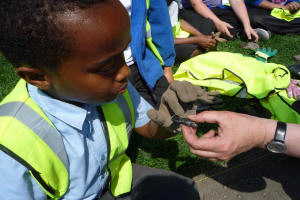Old toys show plus side to losing your marbles
11 Jul 2013
A collection of long lost toys, just unearthed by a team of University archaeologists on a dig at Whitworth Park, have shone new light on the commercialisation of childhood by the late Victorians.

The Whitworth Park Community Archaeology Project is one of the first projects to expose and explore the rich history of everyday life in public parks between the 1890s and 1950s.
Among the finds are beautifully preserved fragments of a child's tea set, a toy pistol, a miniature lead soldier, and ceramic “Jacks” game pieces - all early examples of commercially produced toys from the late 19th and very early 20th centuries.
The team also excavated glass balls, removed from “cod bottles” for playing with, alongside mass produced marbles, presumably used by better-off children
Professor Sian Jones, who leads the project: says: "Historical sources provide information on the development of public parks and the ideas behind them - but there's little record of what ordinary people got up to in parks and this is why this project is so unique.
"One person’s rubbish is another person’s treasure: something dropped by the edge of the lake over a hundred years ago gives archaeologists a huge amount of important - and often forgotten - detail about what life was like in those times.
"So the work not only shines a welcome light on the lives of children, but on other intimate items of daily life, such as buttons, parts of shoes and even gentleman's pipes.
“The artefacts provide a visceral connection to past lives and shed light on the important cultural heritage of public parks."
Her fellow researcher Ruth Colton added: "Better-off members of the working class were able to buy marbles, toy soldiers, spinning tops, skipping ropes, “Jacks” (also know as knucklebones or five stones) and coloured pick up sticks, while meccano and plasticine became widely available in the early twentieth century.
"But poorer children were still exposed to advertising and the displays in the windows of toy shops, such as one just outside Whitworth Park.
"So these poorer children made their own toy boats, dolls and other games, though they also competed with other children for marbles as well as “recycling” the glass balls from “cod bottles” to play with.”
The Project is led by the Archaeology Department with partners The Friends of Whitworth Park, Manchester Museum, Whitworth Art Gallery and the Ahmed Iqbal Ullah Race Relations Resource Centre. Participants in the project have included local community volunteers, schools, long-term unemployed people, and the CBA Young Archaeologists' Club.
- Whitworth Park Community Archaeology and History Project finishes on Saturday 13 July with a Manchester Museum 'Big Saturday'.
